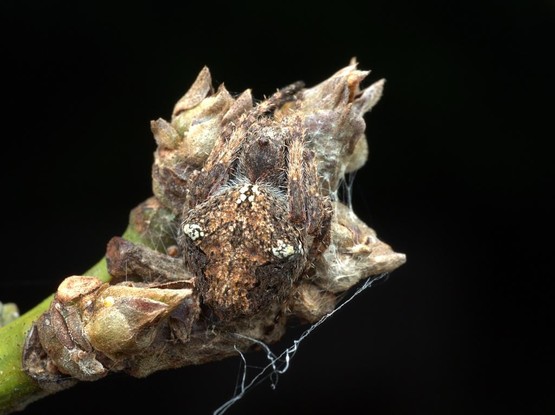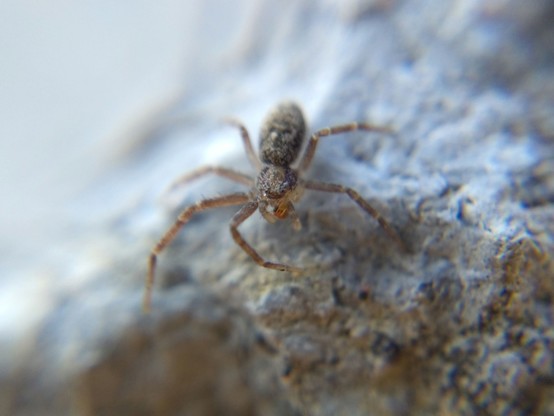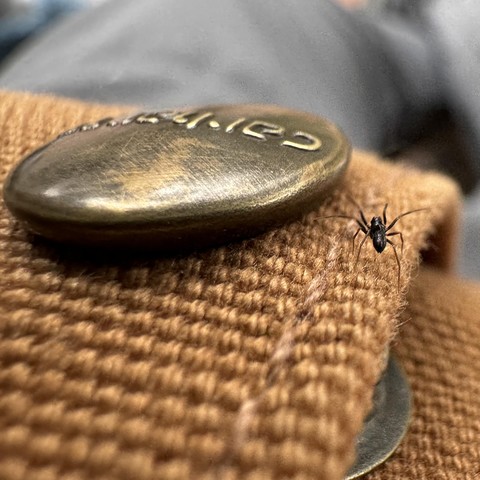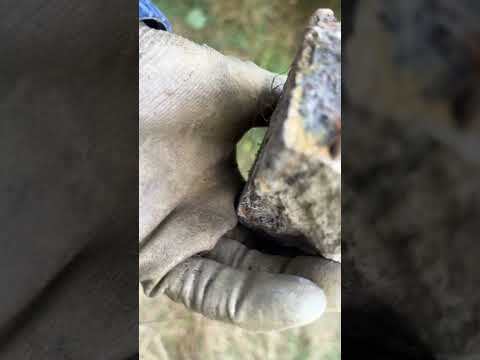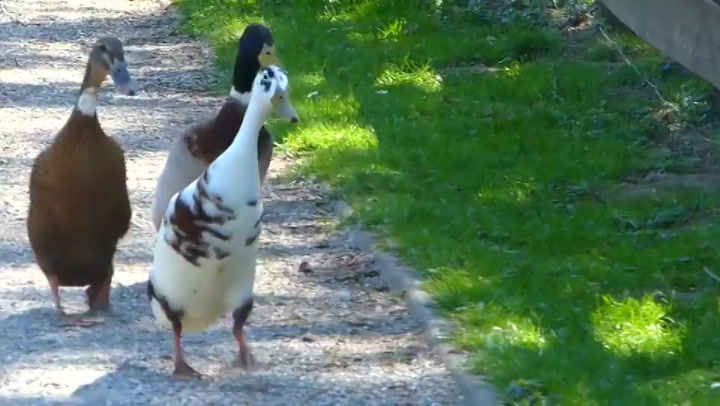Recent searches
Search options
#spiders
Socca pustulosa (Knobbled Orbweaver)
Observed on 2024-04-21
By: flossiepip
Location: Ruawai, New Zealand
iNaturalist link: https://www.inaturalist.org/observations/234791337
Photo credits: (c) Tom, some rights reserved (CC BY)
Learn more about the taxon: https://en.wikipedia.org/wiki/Socca_pustulosa
Yesterday I was bitten by a spider (and quite a large one seeing the marks) and today I woke up with no superpowers.
1/10, wouldn't recommend.
I almost forgot it was #MiteMonday! Inspired by @zorbama's shot of a running crab spider, clover mite, and midge all together (https://veganism.social/@zorbama/114373000260983349), here's a running crab spider (_Philodromus_) I found feeding on a clover mite (_Bryobia_). I don't actually often find many arthropods feeding on the adults, though I've seen predatory _Anystis_ mites eating the eggs.
Red-Backed Jumping Spider Portrait
Jumping spiders like this female red-backed jumping spider are my favourite subjects in macro photography. Their inquisitive, friendly nature is always fun to capture.
Both my current spiders (cobweb spider and cellar spider) molted this week!
OK, so you know how instead of gradually turning rust-red like iron does, copper turns from, well, copper to light blueish-green, and how copper compounds will turn a flame blue-green? Well, arthropod hemolymph (their equivalent of blood) uses copper-containing proteins to transport oxygen, and so spider "blood" is blueish-green—like how our iron-rich blood is red.
You usually can't see it, but right after molting this spider is unusually translucent (the exoskeleton is still hardening up) and the legs still have a distinct blue-green hue.
Bonus pic: ._.
Title: Unvanquished
️ What's: A libre team-based FPS/RTS game pitting humans vs aliens
️ https://www.unvanquished.net
️ https://github.com/Unvanquished
#LinuxGaming #ShareYourGames #Flagship #RTS #FPS #SciFi #Spiders
️ #Libre #Bin #Arch #RPM #Deb #Flatpak
Our entry: https://lebottinlinux.vps.a-lec.org/LO.html
️ Update: 0.55.3
New Mod
️ Changes: https://unvanquished.net/unvanquished-0-55-3-tonemapped-vampires/
️ From: https://idtech.space/objects/6830ff92-23f2-44a8-96b7-ee69b2ca2371
https://www.youtube.com/embed/GdcWH52z8KM
️ https://www.youtube.com/embed/5Zq_kVlqt34
️
️
️ https://www.youtube.com/watch?v=nyzYabXS4W4
️ https://vdo.unvanquished.greboca.com/videos/embed/ogoFSa6jQYyzM5H1EUtzm4
Micro portrait of a really Itsy bitsy tiny spider in the flowerleaf of a rose in the garden for today's timeline cleanser. Don't be scared
This reddit comment on #spiders #ants and #bees is quite interesting
https://www.reddit.com/r/NatureIsFuckingLit/comments/1jwpxxs/comment/mmm3m7i/
Copying it here if you don't want to click, links with reference at the end might be broken.
-- /u/lamplorde --
So I'm gonna bore people because I'm a bug nerd but:
There is a lot more going on in the insect world than we give credit to, because we simply dont have the technology to accurately study them at that size. Its funny to think about when we have microscopes that let us see the fundamental building blocks of the universe, but when it comes to insect physiology and how their brains work we know very little.
For instance, studies have lead to the theory that Bees most likely do have emotions. It was a simple study, done using Blue Flowers and the fact that Bees still kept a "heightened state" around the color blue when they started to associate it with food. But it doesnt stop there: there were also studies done on Ant colonies regarding their sleep schedules and we came to find that Carpenter Fire Ant Queens sleep for about the same amount of time as us humans, just in lots of little naps. But the interesting part of that one is not just how much they sleep but how. Scientists observed the Ants antenna twitching very similarly to our eyes during REM sleep, leading to the theory that Ants might dream. One last fun tidbit: Jumping Spiders are opportunistic pack hunters. They spend most of their life solitary, but are known to hunt together in mated pairs, becoming extremely effective together with the smaller Male often distracting the prey while the Female pounces. The odd part comes from the fact that they appear to communicate before hunts via a "language" done through foot stamping to plan. Not only that but Jumping Spiders are one of the few insects that display an understanding of Object Permanence, ranking them at least a little above an infant (not that that is saying much).
At the end of the day, we have so much going on below our feet. Entire little lives that we know so little about. Its an interesting and vibrant world.
EDIT By popular demand, things I should have included to begin with (the all important sources):
Bees and Emotion
Ants and Dreaming (My apologies, it was Fire Ants, not Carpenters
Jumping Spiders and Object Permanence
Which, when trying to find my old sources funnily enough brought me to a new (to me) study that Jumping Spiders might also dream
Fighting against #bot all the day.
Yesterday, editing a page on my site I noticed a temporary block of a couple of minutes, after investigations my web site server has reported an abnormal use of the available resources and I found out that #crawlers and #spiders was sucking my server resources so I started a journey to #ban ip addresses, let's see what happens.
These pests must be stopped.
Wisst ihr, was ganz cool ist. Wenn man sich selbst aus seiner Angst vor Spinnen rauszieht und sich mit Spinnen anfreundet und dann jeden Frühling bis Herbst massig Möglichkeiten hat, gute Spinnen zu sehen und/oder fotografieren. Hab festgestellt, das waren nun in den letzten 5 Jahren bei mir schon über 200.
https://www.inaturalist.org/observations?taxon_id=47118&user_id=samleipzig&verifiable=any

I'm at Lake Hāwea this week helping teach a field trip for our Masters level Conservation Biology course at #LincolnUniversityNZ. The surprise find so far has been the lizard team's discovery of redback spiders on the university's Mount Grand high country station.
These are Australian venomous spiders related to black widows and NZ's katipō. Redbacks have been established around Cromwell and Alexandra and are spreading.
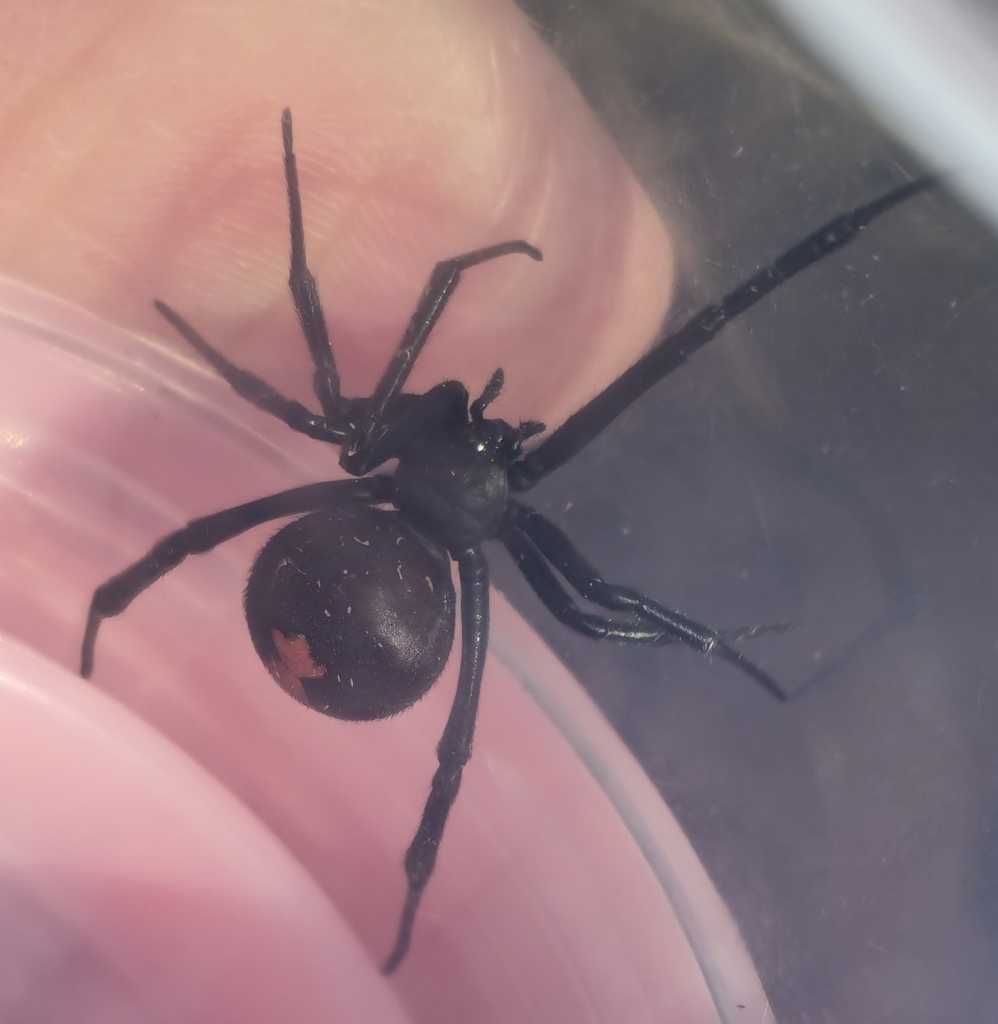
One of my favourite things about being Australian on the internet is coming across comment threads on spider-related videos full of Aussies discussing their household huntsman spiders, and front-path orb weavers etc., their names, life stories, RIP messages telling of their sad demises when encountering visiting tourists or tradies
A portrait of a curious jumping spider for #wildlifewednesday
#photography #fotografie #photographie #nature #spiders #macro #macrophotography #pixelfed #fujifilm #pixelfed #naturephotography #photooftheday
La araña Dysdera crocata ha invadido todo el hemisferio norte y se ha extendido desde todas las zonas del hemisferio sur con clima mediterráneo. No teje tela, sino que permanece oculta en hendiduras y por la noche sale a cazar, alimentándose de cochinillas (Oniscidea) gracias a sus enormes quelíceros. #arañas #spiders
Adventures of a Jumping Spider.
Follow this friendly jumping spider along as it goes on an epic adventure across the backyard.
#SpiderSunday: several of the spiders I met on that one warm day last week! A running crab spider (_Philodromus_), a bold jumping spider (_Phidippus audax_), some kind of crab spider in tribe Coriarachnini (_Bassaniana_?), and a good old zebra jumping spider (_Salticus scenicus_) with what looks like most of a mesh-web weaver (family Dictynidae).


